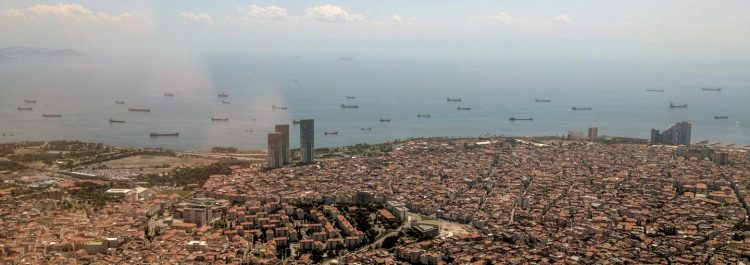Micro-earthquakes preceding a 4.2 earthquake near Istanbul as early warning signs?

Istanbul and the Prince Islands in the background, on which the borehole observatory GONAF is located. (photo: M.Bohnhoff, GFZ)
In a new study, led by Peter Malin and Marco Bohnhoff of the GFZ German Research Center for Geosciences, the authors report on the observation of foreshocks that, if analyzed accordingly and in real-time, may possibly increase the early-warning time before a large earthquake from just a few seconds up to several hours.
However, the authors caution: „The results are so far based on only one – yet encouraging – field example for an ,earthquake preparation sequence' typically known from repeated rock-deformation laboratory experiments under controlled conditions”, says Marco Bohnhoff.
The study from Peter Malin and Marco Bohnhoff, together with colleagues from the AFAD Disaster and Emergency Management Presidency in Turkey, uses waveform data from the recently implemented GONAF borehole seismic network. GONAF operates at low-magnitude detection. It allowed identifying a series of micro-earthquakes prior to an earthquake of magnitude 4.2 which occurred in June 2016 south of Istanbul and which was the largest event in the region in several years.
In the latest issue of Scientific Reports, seismic data from the GONAF network, set up by GFZ in collaboration with AFAD along the Marmara Sea near Istanbul, is processed and analyzed with novel processing techniques. The high resolution borehole seismic array allowed for the detection of tens of seismic events prior to the mainshock. These small events would have been below the detection threshold of most seismic networks worldwide.
By means of the new processing technique, clustering and similarity of the seismic signals was shown to substantially increase in the hours prior to the Mw 4.2 earthquake. If this so-called emergent failure process would be a persistent feature of seismicity there, implementing real-time processing of the novel technique could extend the warning time for future earthquakes in the Istanbul region and lead to a major improvement in the early-warning system for the densely populated area of the Turkish megacity.
“Our study shows a substantial increase in self-similarity of the micro-quakes during the hours before the mainshock,” says Professor Bohnhoff of the GFZ; “while the current early-warning system in place in Istanbul relies on the arrival times of seismic waves emitted from the hypocentre to the city and is therefore restricted to a couple of seconds at maximum”.
While similar precursory activity has been detected for recent large earthquakes in Japan (2011 Mw9 Tohoku-Oki) and Chile (2014 Mw8.1 Iquique), this is at present by no means a ubiquitous observation and needs further testing before its implementation.
###
Original study: Malin, E.P., Bohnhoff, M., Blümle, F., Dresen, G., Martínez-Garzón, P., Nurlu, M., Ceken, U., Kadirioglu, F.T., Kartal, R.F., Kilic, T., Yanik, K., 2018. Microearthquakes preceding a M4.2 Earthquake Offshore Istanbul. Nature Scientific Reports. DOI: 10.1038/s41598-018-34563-9
Figures:
BU_de: Istanbul und im Hintergrund die Prinzeninseln, auf denen sich das Bohrlochobservatorium GONAF befindet (Foto: M. Bohnhoff, GFZ).
BU_en: Istanbul and the Prince Islands in the background, on which the borehole observatory GONAF is located (photo: M. Bohnhoff, GFZ).
Link: https:/
BU_de:
Darstellung der Nordanatolischen Verwerfungszone (CCBY 3.0: Bohnhoff et.al., Scientific Drilling, 5, 1-10, 2017, doi:10.5194/sd-5-1-2017)
BU_en:
Illustration of the North Anatolian fault zone (CCBY 3.0: Bohnhoff et.al., Scientific Drilling, 5, 1-10, 2017, doi:10.5194/sd-5-1-2017).
Link: https:/
Media Contact
More Information:
http://dx.doi.org/10.1038/s41598-018-34563-9All latest news from the category: Earth Sciences
Earth Sciences (also referred to as Geosciences), which deals with basic issues surrounding our planet, plays a vital role in the area of energy and raw materials supply.
Earth Sciences comprises subjects such as geology, geography, geological informatics, paleontology, mineralogy, petrography, crystallography, geophysics, geodesy, glaciology, cartography, photogrammetry, meteorology and seismology, early-warning systems, earthquake research and polar research.
Newest articles

Long-sought structure of powerful anticancer natural product
…solved by integrated approach. A collaborative effort by the research groups of Professor Haruhiko Fuwa from Chuo University and Professor Masashi Tsuda from Kochi University has culminated in the structure…

Making a difference: Efficient water harvesting from air possible
Copolymer solution uses water-loving differential to induce desorption at lower temperatures. Harvesting water from the air and decreasing humidity are crucial to realizing a more comfortable life for humanity. Water-adsorption…

In major materials breakthrough
UVA team solves a nearly 200-year-old challenge in polymers. UVA researchers defy materials science rules with molecules that release stored length to decouple stiffness and stretchability. Researchers at the University…



